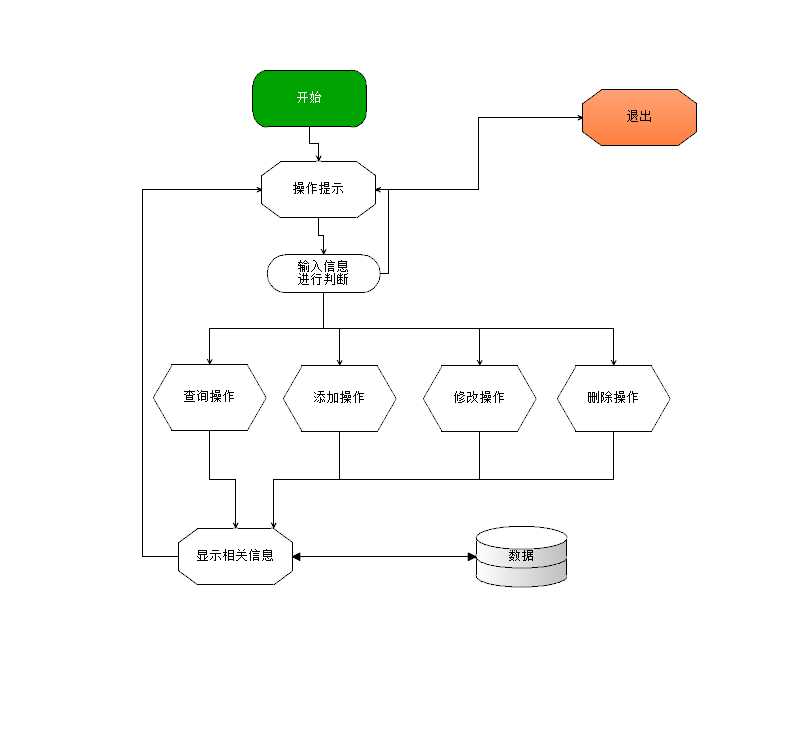标签:format 自增 执行 div 重复 分享 _id where dir
作业 1: 员工信息表程序,实现增删改查操作
可进行模糊查询,语法至少支持下面3种:
select name,age from staff_table where age > 22
select * from staff_table where dept = "IT"
select * from staff_table where enroll_date like "2013"
查到的信息,打印后,最后面还要显示查到的条数
可创建新员工纪录,以phone做唯一键,staff_id需自增
可删除指定员工信息纪录,输入员工id,即可删除
可修改员工信息,语法如下:
UPDATE staff_table SET dept="Market" WHERE where dept = "IT"
注意:以上需求,要充分使用函数,请尽你的最大限度来减少重复代码
详细描述参考http://www.cnblogs.com/alex3714/articles/5740985.html

代码才写了一半,今天 有公开课就没有写完成!先上一部分,明天再战

1 #!usr/bin/env python 2 #-*-coding:utf-8-*- 3 # Author calmyan 4 import os ,sys 5 BASE_DIR=os.path.dirname(os.path.abspath(__file__))#获取相对路径转为绝对路径赋于变量 6 sys.path.append(BASE_DIR)#增加环境变量 7 8 select_=‘select‘#定义关键字 9 from_=‘from‘ 10 where_=‘where‘ 11 update_=‘update‘ 12 delete_=‘delete‘ 13 insert_=‘insert‘ 14 values_=‘values‘ 15 into_=‘into‘ 16 set_=‘set‘ 17 18 def fj(line):#分解字符串 19 a=line.split(‘,‘)#用 , 分割为列表 20 dict_list={}#定义一个字典 21 dict_list[a[3]]={‘id‘:int(a[0]),‘name‘:a[1],‘age‘:int(a[2]),‘dept‘:a[4],‘ennoll_date‘:a[5].strip()} 22 #print(dict_list) 23 return dict_list# 24 25 def dict_info(file_name):#员工信息表提取函数 26 user_dict={}#定义一个员工信息的字典 27 with open(file_name,‘r‘,encoding=‘utf-8‘) as user_info: 28 for line in user_info: 29 user_dict.update(fj(line))#更新员工信息的字典 30 return user_dict 31 32 33 def sql_parsing(sql):#sql解析函数 主入口 34 #sql=sql.lower() 35 print(sql) 36 if sql.startswith(‘select‘):#判断语句类型 37 _dict_=select_par(sql)#调用相关函数 38 elif sql.startswith(‘update‘) or sql.startswith(‘UPDATE‘) :#判断语句类型 39 _dict_=update_par(sql.lower()) 40 elif sql.startswith(‘insert‘):#判断语句类型 41 _dict_=insert_par(sql) 42 elif sql.startswith(‘delete‘): 43 _dict_=delete_par(sql) 44 else: 45 print(‘输入有误,请重新输入!‘) 46 return _dict_#返回解析完成的列表 47 48 49 def select_par(sql):#select语句的解析函数 50 list_key=parsing(sql,index_select=-1,index_from=-1,index_where=-1,select_=select_,where_=where_,from_=from_)#查询调用 51 return list_key 52 def update_par(sql):#update语句的解析函数 53 list_key=parsing(sql,index_update=-1,index_set=-1,update_=update_,set_=set_,where_=where_)#更新修改调用 54 return list_key 55 def insert_par(sql):#insert语句的解析函数 56 list_key=parsing(sql,index_insert=-1,index_into=-1,index_values=-1,insert_=insert_,values_=values_)#添加调用 57 return list_key 58 59 def delete_par(sql):#delete语句的解析函数 60 list_key=parsing(sql,index_delete=-1,index_from=-1,index_where=-1,delete_=delete_,where_=where_,from_=from_)#删除调用 61 return list_key 62 63 64 65 66 def where_format(where_list):#格式化where 子句函数 67 #print(where_list) 68 list_format=[] 69 key_=[‘and‘,‘or‘,‘like‘,‘not‘] 70 str=‘‘#字符连接变量 71 for i in where_list: 72 if len(i)==0:continue#如果为空就不连接 73 if i not in key_:##如果不是关键字就进行连接 74 str+=i 75 elif i in key_ and len(str)!=0: 76 list_format.append(str)#之前的字符串添加到列表 77 list_format.append(i)#关键 字添加到列表 78 str=‘‘#清空变量 备用 79 # if i in key_ and len(str)!=0:#如果循环到关键 字 80 # list_format.append(str)#之前的字符串添加到列表 81 # list_format.append(i)#关键 字添加到列表 82 # str=‘‘#清空变量 备用 83 # else:#如果不是关键字就进行连接 84 # str+=i#字符连接 85 # print(str) 86 list_format.append(str)#最后的字符串 87 #print(list_format) 88 return list_format 89 90 def select_format(select_list):#格式化select函数 91 print(select_list) 92 #str=‘‘ 93 if select_list[0]==‘*‘:#如果为* 就不改动 94 pass 95 else: 96 # for i in select_list:#列表内容转为字符串 97 # str+=i 98 list_=str_conn(select_list).split(‘,‘)#字符串连接函数 99 #list_=str.split(‘,‘)# 100 print(list_) 101 return list_ 102 103 #字符串连接函数 104 def str_conn(list): 105 str=‘‘ 106 for i in list: 107 str+=i 108 return str 109 110 111 def parsing(sql,**kwargs):#select语句的解析函数 112 list_l=sql.split(‘ ‘)#分割存为列表 113 index_from=-1#下标定义from 114 index_select=-1#select 115 index_where=-1#where 116 index_update=-1#update 117 index_set=-1#set 118 index_delete=-1#delete 119 index_insert=-1#insert 120 index_values=-1#valuse 121 list_key={‘select‘:[],‘update‘:[],‘delete‘:[],‘insert‘:[],‘set‘:[],‘from‘:[],‘into‘:[],‘where‘:[],‘values‘:[]}#定义要处理的关键字字典 122 for index,i in enumerate(list_l):#获取下标 123 if i==select_:#如果是关键字select字典下标 124 index_select=index 125 if i==update_:#如果是关键字update字典下标,全部转为小写 126 index_update=index 127 if i==set_: 128 index_set=index 129 if i==insert_:#如果是关键字insert字典下标 130 index_insert=index 131 if i==into_: 132 index_into=index 133 if i==values_: 134 index_values=index 135 if i==delete_: 136 index_delete=index 137 if i==from_:#如果是关键字from字典下标 138 index_from=index 139 if i==where_:#如果是关键字where字典下标 140 index_where=index 141 142 for index,i in enumerate(list_l):#用下标界定,对进行关键字字典的添加 143 if index_select !=-1 and index>index_select and index<index_from:#在select和from中添加到select中,不为空时 144 list_key[select_].append(i)#添加当前值 145 if index_update !=-1 and index==index_update:#如果是update语句添加一个1值 146 list_key[update_].append(1) 147 if index_insert !=-1 and index==index_insert:#如果是insert语句添加一个1值 148 list_key[insert_].append(1) 149 if index_delete !=-1 and index==index_delete:#如果是delete语句添加一个1值 150 list_key[delete_].append(1) 151 if index_from!=-1 and index>index_from and index<index_where:#添加from中的值 152 list_key[from_].append(i) 153 if index_set!=-1 and index>index_set and index<index_where: 154 list_key[set_].append(i) 155 if index_where!=-1 and index>index_where: 156 list_key[where_].append(i) 157 if index_values!=-1 and index>index_values: 158 list_key[values_].append(i) 159 if list_key.get(where_):#如果字典在的列表不为空 160 list_key[where_]=where_format(list_key.get(where_))#进行格式化,重新赋于字典,调用格式化函数 161 if list_key.get(select_):#如果字典select在的列表不为空 162 list_key[select_]=select_format(list_key.get(select_))#进行格式化,重新赋于字典 163 if list_key.get(values_):#如果字典values在的列表不为空 164 list_key[values_]=select_format(list_key.get(values_))#进行格式化,重新赋于字典 165 return list_key 166 167 #执行部分 168 def sql_perform(sql_dict):#执行函数 169 print() 170 171 def perform_select(sql_dict):#执行select操作的函数 172 select_dict=sql_dict 173 return select_dict#返回处理后的信息 174 175 def perform_update(sql_dict):#执行update操作的函数 176 select_dict=sql_dict 177 return select_dict#返回处理后的信息 178 179 def perform_insert(sql_dict):#执行insert操作的函数 180 select_dict=sql_dict 181 return select_dict#返回处理后的信息 182 183 def perform_delete(sql_dict):#执行delete操作的函数 184 select_dict=sql_dict 185 return select_dict#返回处理后的信息 186 187 188 189 190 191 192 193 print("\033[35;1m欢迎进入员工信息表查询系统\033[0m".center(60,‘=‘)) 194 if __name__ ==‘__main__‘: 195 while True: 196 print(‘查询修改示例‘.center(50,‘-‘).center(60,‘ ‘)) 197 print(‘‘‘ 198 \033[32;1m1、 select name,age from staff_table where age>22\033[0m 199 \033[31;1m2、 UPDATE staff_table SET dept="Market" WHERE dept="IT"\033[0m 200 \033[33;1m3、 insert into staff_table values Alex Li,22,13651054608,IT,2013-04-01\033[0m 201 \033[32;1m3、 delete from staff_table where id=5 \033[0m 202 ‘‘‘) 203 sql=input(‘sql->‘).strip()#定义显示提示符 204 if sql==‘exit‘:break#如果输入exit退出 205 if sql==0:continue#如何没输入重新提示 206 sql_dict=sql_parsing(sql)#解析输入的sql语句 207 print(sql_dict) 208 sql_action=sql_perform(sql_dict)#执行解析后的语句 209 file_name=‘db/staff_table‘ 210 #print(dict_info(file_name))#传入要查询的表名 211 user_info=dict_info(file_name)#传入要查询的表名,添加到字典
标签:format 自增 执行 div 重复 分享 _id where dir
原文地址:http://www.cnblogs.com/uge3/p/6870199.html